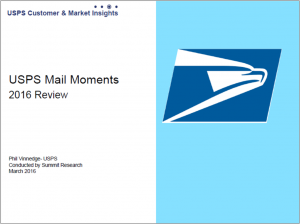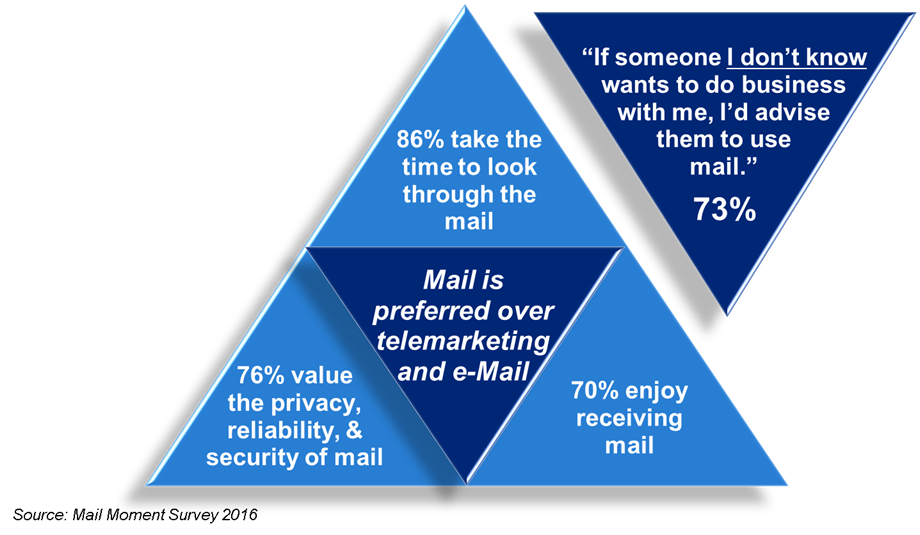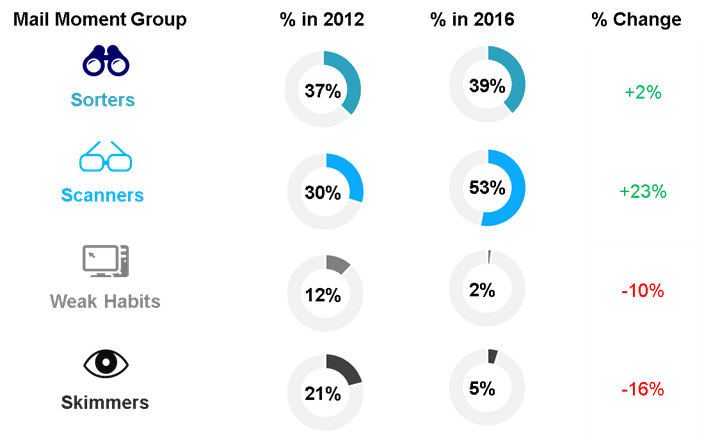USPS Customer & Market Insights Image Align Right
 We’ve said it all before — direct mail delivers, direct mail gets read, and it cuts through the clutter! In addition to backing previously reported data, the latest findings from a Mail Moments study further unveil how consumers respond to the mail they receive as well as their preferences about what is delivered to their mailboxes. Earlier this year, the USPS commissioned Summit Research to conduct an online survey that strove to understand mail behaviors and overall mail habits as they relate to billing. The findings reveal insights from over 1,500 consumers across a variety of age demographics that are involved with mail-related activities like mail sorting, shopping, or bill management. Some of the key findings are as follows:
We’ve said it all before — direct mail delivers, direct mail gets read, and it cuts through the clutter! In addition to backing previously reported data, the latest findings from a Mail Moments study further unveil how consumers respond to the mail they receive as well as their preferences about what is delivered to their mailboxes. Earlier this year, the USPS commissioned Summit Research to conduct an online survey that strove to understand mail behaviors and overall mail habits as they relate to billing. The findings reveal insights from over 1,500 consumers across a variety of age demographics that are involved with mail-related activities like mail sorting, shopping, or bill management. Some of the key findings are as follows:
- Overall mail engagement has increased since 2012, and Millennials are at least as engaged with the mail as non-Millennials.
- Regardless of age, most consumers get their mail at the first opportunity and also sort it at the first opportunity (usually the same day), confirming the high value of mail.
- Although they receive less mail overall, Millennials spend more time sorting their mail and are more active consumers of mail.
- The role of bills in the mail remains important to all generations—although Millennials are more comfortable with digital-only options.
- Nearly half of households consider pure online bill receipt and payment undesirable. As might be expected, however, this undesirability increases with age from just over a third of Millennials (34%) to over half of Boomers (54%).
- Even if there were an easy-to-use integrated billing portal, most consumers would still want some bills or statements sent via mail.
According to the survey, mail is preferred over telemarketing and e-mail communications and remains important to most households. Furthermore, many households would actually prefer to receive more mail instead of less. Respondents that felt this way reported that more mail can actually be productive for the sender—these individuals look forward to receiving mail, don’t see it as a chore, or would rather review physical mail instead of e-mail when seeking useful information.

The survey includes additional findings on behaviors that are broken down by age and the following behavioral categories:
- Sorters have a strong attachment to the mail. A sorter will categorize all of the mail that they receive and file important pieces for later use.
- Scanners have a lower attachment to the mail than Sorters. These individuals will occasionally discard pieces without reading them, but they still see value in the mail.
- Weak Habits have little attachment to the mail. This subgroup lacks basic mail consumption habits and does not see value in organizing mail.
- Skimmers are active detractors and have no attachment at all to the mail. Skimmers will pay attention only to items of extreme importance.
According to the findings from Mail Moments, the share of “Scanners” saw the greatest increase (23%) between 2012 and 2016, while the share of “Skimmers” saw the largest decline (16%).

Within the Mail Moments report, you will find much more information about how the mail preferences and behaviors of these groups are changing over time. Contrary to popular belief, the report confirms that mail is still highly valued among consumers. Regardless of age, most consumers get their mail at the first opportunity and also sort it as soon as they can. Click here to learn more about Scanners, Skimmers, and others as well as how to better meet consumers’ direct mail needs in 2017!
Source: Inno Media, 2012, Mail Moments Segments based off national survey of 1,078 heads of households.
Click here for the USPS Mail Moments 2016 Review pdf.
